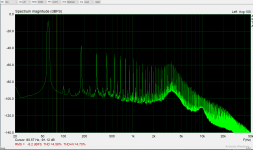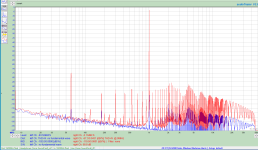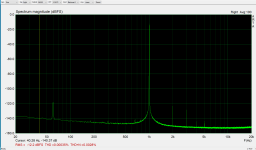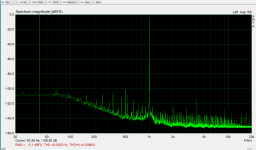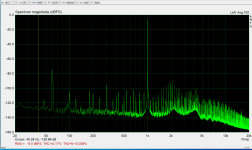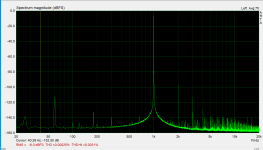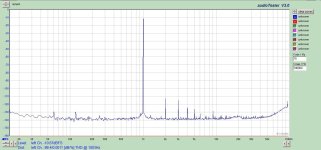I don't want to put too much in one post so I am breaking this up.
Next we see conducted line noise measured from a 2.5VAC seprp down transformer through a resistor divider to prevent over driving the input to the sound card.
I suspect the noise in post 40 are due to the internal switching power supplies in the computer. Not much can be done about that.
The second attachment is using the Viktors LDO driving the Strix Raid soundcard. Noise is terrible. Power is derived from a FWB followed by 1000ufCap and then a LM317 regulator. Isuspect ground loops are allowing noise into the system.
So I dug out an E-MU0404 to test with.
Next we see conducted line noise measured from a 2.5VAC seprp down transformer through a resistor divider to prevent over driving the input to the sound card.
I suspect the noise in post 40 are due to the internal switching power supplies in the computer. Not much can be done about that.
The second attachment is using the Viktors LDO driving the Strix Raid soundcard. Noise is terrible. Power is derived from a FWB followed by 1000ufCap and then a LM317 regulator. Isuspect ground loops are allowing noise into the system.
So I dug out an E-MU0404 to test with.
Attachments
With the E-MU404 (USB) I get much cleaner scans. This is the same oscillator as the second scan in post 41 (different software program AudioTester 3D vs ARTA but different FFT programs show the same results).
I will post the second issue another time.
I will post the second issue another time.
Attachments
I do have some Edcor WSM 10K to 10K isolation transformers (I just remembered tonight).
I am thinking if I
(1) un-install the E-MU0404 and it's drivers, and
(2) re-install the Strix RAID DLX drivers and card, and
(3) use the isolation transformers at the output of the LDO oscillator to break any ground loop, it should show much lower noise.
Would this confirm that I have a ground loop problem? My suspicion is yes.
I am thinking if I
(1) un-install the E-MU0404 and it's drivers, and
(2) re-install the Strix RAID DLX drivers and card, and
(3) use the isolation transformers at the output of the LDO oscillator to break any ground loop, it should show much lower noise.
Would this confirm that I have a ground loop problem? My suspicion is yes.
Last edited:
How is the output when running Victor’s LDO from batteries? I noticed only a slight difference between batteries and a power supply.
I use a very simple and low budget 9 Volt wall-wart with a cheap stepup chip from AliExpress with only slight extra filtering to get 36 Volt.
Regards, Gerrit
I use a very simple and low budget 9 Volt wall-wart with a cheap stepup chip from AliExpress with only slight extra filtering to get 36 Volt.
Regards, Gerrit
I haven't tried batteries, but I think I have enough NiMh cells to do it. 4 would be 36V when fully charged.
I will switch back to the Strix RAID DLX sound card later today and compare line PS to batteries.
I will switch back to the Strix RAID DLX sound card later today and compare line PS to batteries.
I suspect some type of coupling or ground currents. Using a usb sound card to play music from my laptop is dead quite. Using the same sound card on a desktop computer results in a lot of high frequency background noise. This is with everything plugged into the same outlet.
People report good results on a bank of 9v batteries feeding an LM317HV for Viktor’s oscillator.
People report good results on a bank of 9v batteries feeding an LM317HV for Viktor’s oscillator.
Looks like it is ground loop issues. I installed the STRIX sound card and re-ran the tests including loop-back which looks pretty clean except the LF noise floor.
First is loop-back, then Viktors LDO, and finally Viktors LDO removed from the aluminum enclosure (which broke the ground).
First is loop-back, then Viktors LDO, and finally Viktors LDO removed from the aluminum enclosure (which broke the ground).
Attachments
Try using a soft iron core 1:1 mains transformer at good VA rating to feed your equipment, use capacitors on output to filter around 200 Hz at least. Ferrite cores are terrible to use in HF environments, conducted EMI is a real dog to get rid of.
I use Triad N-90MD (Medical Grade) isolation transformers. I will try re-allocating where things are plugged in to see if I can reduce some of the noise.
Truly, I have had better audio quality from a crappy old pofs miller generator (aead200) with its running noise in the background, it was better sound coming from my aca 5w than grid power.
I was surprised how bad our power quality was so I am now running an diy sort of chinese 24 mosfet LF inverter from solar panels. Its really good, not as much iron as the miller, so i think theres something else going on with maybe some switching noise in the inverter setup, compared to the very analog output nature of the generator.
But, If any of you want the best sound possible, consider safely implementing high current lifepo4 battery banks.
You could do lead acid too, i think 2 tractor batteris powering a sevant grade amp definetly is in the spirit of diy...
Dont f with lions though they are too volatile and too finicky in balancing and charging.
These are my findings as of now, the lf inverter is a fair compromise. I have tried isolation transformers with no noticeable sound difference, other than maybe more bass?
I was surprised how bad our power quality was so I am now running an diy sort of chinese 24 mosfet LF inverter from solar panels. Its really good, not as much iron as the miller, so i think theres something else going on with maybe some switching noise in the inverter setup, compared to the very analog output nature of the generator.
But, If any of you want the best sound possible, consider safely implementing high current lifepo4 battery banks.
You could do lead acid too, i think 2 tractor batteris powering a sevant grade amp definetly is in the spirit of diy...
Dont f with lions though they are too volatile and too finicky in balancing and charging.
These are my findings as of now, the lf inverter is a fair compromise. I have tried isolation transformers with no noticeable sound difference, other than maybe more bass?
Correct; also the on/off blinking cycle of my Weller soldering iron messes with the mains, that had me looking for a fault elsewhere that bogged me down. At certain times of the day I also pick up wretched windfarm line modulation, though the nearest windpark is away unseen but the overhead lines act as radiator aerials. This really shags the AM spectrum to unusable but the modulated EMI is terrible.The cheap fluorescent magnifying light on my bench spews 30khz hash when test leads are near it. Fooled me a few times already.
On another note, I use SMPS (continuous mode operation ) Power factor circuitry in my power amps designed for 1kW; despite the enormous amount of filtering it is nearly impossible to avoid some chassis emission pickup in the FM band.
South texas it gets hot, you can really notice when ALL of the ac units are full on. The entire grid gets stressed and line losses increase. Im sure that is translating to lower power quality and lower sound quality in every case.
I think for reference systems, true reference systems, even multi-million dollar systems, and tube systems, and show systems, It should be run off a battery where indisputable completely isolated dc power is being utilized.
Same with measurement labs, why bother with noise suppression, when batteries eliminate the noise from the power source?
That's why portable daps are great in one respect. Grid noise is probably irrelevant, and when you dabble with 120v preamp and dac stages in a system, there is always noisy electronics, rectifying ac voltage, and stepping down dc voltage for all the little different powered devices.
What do you guys think about battery powered systems, and battery powered sources for noise suppression? What are the drawbacks? (expecially when its real easy to charge a battery with 1 or 2 solar panels you can purchase used for super cheap)
I think for reference systems, true reference systems, even multi-million dollar systems, and tube systems, and show systems, It should be run off a battery where indisputable completely isolated dc power is being utilized.
Same with measurement labs, why bother with noise suppression, when batteries eliminate the noise from the power source?
That's why portable daps are great in one respect. Grid noise is probably irrelevant, and when you dabble with 120v preamp and dac stages in a system, there is always noisy electronics, rectifying ac voltage, and stepping down dc voltage for all the little different powered devices.
What do you guys think about battery powered systems, and battery powered sources for noise suppression? What are the drawbacks? (expecially when its real easy to charge a battery with 1 or 2 solar panels you can purchase used for super cheap)
OK, so you have a battery supply. It drives a DC to AC switching supply. The output is not a pure sine wave (for every commercial inverter I have seen) and is generated by switching at 20-30KHz to produce a step-wise sin wave.
This would eliminate a lot of conducted noise, however it would have to be isolated to supply only your audio system. And it would have it's own noise profile.
How much power do you need?
How many hours per day do you listen?
How do you recharge the battery?
This would eliminate a lot of conducted noise, however it would have to be isolated to supply only your audio system. And it would have it's own noise profile.
How much power do you need?
How many hours per day do you listen?
How do you recharge the battery?
You would need a true sine wave inverter like the ones PS Audio makes to get clean AC and those are very expensive! Most inverters are stepped not true sine. That’s as bad or worse than the grid power for noise and high distortion. It you’re talking about using a stack of deep cycle batteries to get your B+ that is expensive and massive in size and weight. Charging them will be an issue as you’ll need a system to charge one or two at a time and since you’ll need more than 20 to get the voltages needed it’s not practical. It will be so heavy that the house will be stressed! That doesn’t even talk about the expense! It would cost more than the PS Audio device.
If line noise and distortion are making their way into your amplifier then you do not have adequate power supply filtering.
Power supply filtering does not account for ambient power demands, resonances, and undefined noises on a power line. Not all noise is measured in hertz you know.
Larger capacitor banks are nice, but there are still intercapacitor noises that cannot beat a lifepo4 1000a+++ continuous power delivery.
You would not be better off with the ps overpriced supply, Ive been there, talked to those guys, heard their system, wow, it was disappointing, and that's what youd expect from any class d amplifier (Thats what was in thier coveted, but sloppy-put-together listening room), especially at that price range. Its absurd, really its a chinese under the table handjob company, like emotiva, that sells unimpressive, marketed as top of the line impressive, JUNK fact of the matter. Im ready for the dissenting opinions.
That just infuriating to those who put in the consideration and effort.
Larger capacitor banks are nice, but there are still intercapacitor noises that cannot beat a lifepo4 1000a+++ continuous power delivery.
You would not be better off with the ps overpriced supply, Ive been there, talked to those guys, heard their system, wow, it was disappointing, and that's what youd expect from any class d amplifier (Thats what was in thier coveted, but sloppy-put-together listening room), especially at that price range. Its absurd, really its a chinese under the table handjob company, like emotiva, that sells unimpressive, marketed as top of the line impressive, JUNK fact of the matter. Im ready for the dissenting opinions.
That just infuriating to those who put in the consideration and effort.
I would generalize the statement that unless you have 10% voltage distortion or wiring problems, the poor audio performance is due to a poor amplifier. So many threads on this forum about some religious quest to clean up 'dirty' power. Stop blaming the power, start blaming a poor amp.If line noise and distortion are making their way into your amplifier then you do not have adequate power supply filtering.
Go back to the very first post. That line voltage is typical, and any competently designed amplifier will have no issues with it. Easy peasy. After a waste of time and vacillating about every possible reason for the odd performance, it ends up being a ground loop and measurement error.....
Yet here we are continuing to argue for battery supplies and 'perfect' sine wave inverters run from PWM controllers? Good grief, fix your amp or take measurements correctly. Tell me why I have the same 'dirty' power as you do, yet manage to not have problems with noise, hum, buzz, pick your poison. Measurements and FFT's confirm excellent performance.
Still waiting for someone to argue for balanced power and driving isolated ground rods in their basement; the silly band aids just don't stop.
zigzagflux... What amps do you prefer?
Im just saying in order from least to best sounding with all of my testing and building is as follows, as relevant; grid power ~ isolation transformer, grid + toroidal, old analog gasoline generator, off grid solar inverter Lf, lead acid batteries, lion batteries, lifepo4 batteries... but next why not super capacitors in a fully jfet or sit amplifier?
There will never be a perfect amplifier, even after ground noise is eliminated and bias is set perfectly, everything matched, there is still something missing. Maybe someones holding out on us and keeping secrets...
Simple topology class a amplifiers bring alot that's desired. I have no opamps in my system, a perfect amp with perfect opamps still does not sound as nice as the discrete class a.
But that's what we kindof all know or are finding out here anyways.
Im just saying in order from least to best sounding with all of my testing and building is as follows, as relevant; grid power ~ isolation transformer, grid + toroidal, old analog gasoline generator, off grid solar inverter Lf, lead acid batteries, lion batteries, lifepo4 batteries... but next why not super capacitors in a fully jfet or sit amplifier?
There will never be a perfect amplifier, even after ground noise is eliminated and bias is set perfectly, everything matched, there is still something missing. Maybe someones holding out on us and keeping secrets...
Simple topology class a amplifiers bring alot that's desired. I have no opamps in my system, a perfect amp with perfect opamps still does not sound as nice as the discrete class a.
But that's what we kindof all know or are finding out here anyways.
Last edited:
rschmittt100:
I don't see this thread's subject matter being about type of amplifier. The OP posted a bunch of noise in his measurement, and after checking line voltage, initially surmised the 5%-ish distortion of line voltage was responsible for his noise. Post #6 provided an FFT of my line voltage, which looked quite similar to the OP. My recommendation was don't bother blaming line voltage, a competently built amplifier will not have a problem with it.
The OP, after too many rabbit holes and irrelevant anecdotal stories, finally found the typical answer: ground loop and poor measurement process. Stated another way, line voltage was not responsible. We tend to fail to learn this lesson again and again, proved by the never-ending threads about power quality. It is much more interesting for people to provide stories without measurement than it is to accept that perhaps the problem lies in their builds or process. Attachment to one's intellectual work is difficult to overcome.
You reference "something is still missing" and keeping secrets. I really don't know how to respond to that. Sounds a bit conspiratorial. I don't feel my amps are missing anything, if I had to point the finger at a component that needs improvement it would be the speakers, which have measurably higher distortion and show their age. They are also mechanical, so we shouldn't be surprised at them being the weak link. The overall point is it does not matter if you build with tubes, silicon, linear, switching, or resonant: time-tested design practice actually does work, and there is no illuminati knowledge required to build a quiet amplifier.
Example FFT of a test of my preamp. All while using 'dirty' power with fluorescent bulbs, wifi, furnace, washing machine, switching supplies, etc connected to my house power. Did I mention the power was 'dirty'? Why is nothing showing up in the output?
I don't see this thread's subject matter being about type of amplifier. The OP posted a bunch of noise in his measurement, and after checking line voltage, initially surmised the 5%-ish distortion of line voltage was responsible for his noise. Post #6 provided an FFT of my line voltage, which looked quite similar to the OP. My recommendation was don't bother blaming line voltage, a competently built amplifier will not have a problem with it.
The OP, after too many rabbit holes and irrelevant anecdotal stories, finally found the typical answer: ground loop and poor measurement process. Stated another way, line voltage was not responsible. We tend to fail to learn this lesson again and again, proved by the never-ending threads about power quality. It is much more interesting for people to provide stories without measurement than it is to accept that perhaps the problem lies in their builds or process. Attachment to one's intellectual work is difficult to overcome.
You reference "something is still missing" and keeping secrets. I really don't know how to respond to that. Sounds a bit conspiratorial. I don't feel my amps are missing anything, if I had to point the finger at a component that needs improvement it would be the speakers, which have measurably higher distortion and show their age. They are also mechanical, so we shouldn't be surprised at them being the weak link. The overall point is it does not matter if you build with tubes, silicon, linear, switching, or resonant: time-tested design practice actually does work, and there is no illuminati knowledge required to build a quiet amplifier.
Example FFT of a test of my preamp. All while using 'dirty' power with fluorescent bulbs, wifi, furnace, washing machine, switching supplies, etc connected to my house power. Did I mention the power was 'dirty'? Why is nothing showing up in the output?
Attachments
- Home
- Amplifiers
- Tubes / Valves
- Mains power garbage in my amp
